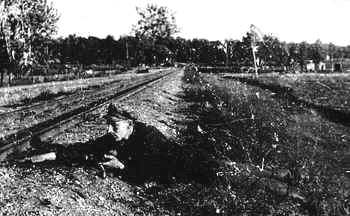Svintsyan Partisans
 The
heavily
forested
areas of Lithuania provided refuge for some
Jews.
Those who could reach the forests established family camps
or became partisans. In Lithuania, this activity took
place in
the Rudniki Forest and Naroch Forest (now in Belarus).
Survival
was difficult, particularly
during the harsh winters. A poem describes how people
sometimes
had to live in order to survive:
The
heavily
forested
areas of Lithuania provided refuge for some
Jews.
Those who could reach the forests established family camps
or became partisans. In Lithuania, this activity took
place in
the Rudniki Forest and Naroch Forest (now in Belarus).
Survival
was difficult, particularly
during the harsh winters. A poem describes how people
sometimes
had to live in order to survive:
The Vice Mayor Invites
All
Former Residents Home
Food often had to be stolen, and people
wishing to join partisan units had to bring their own
weapons.
Nonetheless,
there were eventually more than 50 partisans from
Svintsyan.
Among
them were Yosef Flexer, Feivl Hayat, Shimon Bushkanyetz, Chaya
Porus
(now
Palevsky), and Boris Jochai (seen here placing explosives by a
railroad
track near Vilna).
Statement
of
Boris
Jochai
on His Partisan Activities
Another who became a partisan very early was Peretz Gerzol, or
Greizel,
also mentioned in an account by Bernard Drushkin in The Jewish
Resistance:
The History of the Jewish Partisans in Lithuania and White
Russia
during
the Nazi Occupation 1940-1945.
Yitzhak
Arad
was a partisan too. Arad, a member of Svintsyan's Rudnitzky
family,
was born in Svintsyan although his parents moved to Warsaw when he
was
young. But in 1939, Yitzhak and his sister were sent back to
Svintsyan.
While still a boy, Arad became part of the underground in the
Svintsyan
Ghetto and later fought with a partisan unit in the vicinity of
Vilna.
After World War II, he immigrated to Israel, serving as
Chairman
of Yad Vashem from 1972 to 1993. Dr. Arad is the author of Belzec,
Sobibor,
Treblinka:
The
Operation Reinhard Death Camps,Ghetto in
Flames: The Struggle and Destruction of the Jews of Vilna,
Partisan:
From the Valley of Death to Mount Zion, and
Anthology on Armed Jewish
Resistance. Additionally he was the editor for The
Pictorial
History
of the Holocaust and
The Einsatzgruppen Reports: Selections
from the Dispatches of the Nazi Death Squads' Campaign against
the
Jews:
7/41-1/43, co-edited Documents on the Holocaust:
Selected
Sources on the Destruction of the Jews of Germany and Austria,
Poland,
and the Soviet Union, and contributed to The
Encyclopedia of
the
Holocaust. He has also testified in war crimes trials
in
Israel
and been a consultant for the U.S. Holocaust Memorial Museum.
Following
is a transcript of an interview with Arad about his underground
and
partisan
experiences.
An
Interview with Yitzhak Arad
Mordechai (Motke)
Zeidel was also a partisan from Svintsyan. His story
is at
Yad Vashem, where he has served as one of six "Torchlighters,"
each of
whom represents one million of the six million dead who are
commemorated each year at the annual Holocaust Martyrs and
Heroes
Remembrance Day ceremony. You can watch a YouTube interview with
him here:
Mordechai
Zeidel
More names
of
Svintsyan partisans can be found at the
below
site.
(It will be necessary to choose Advanced Search and then put in
Svencionys
for City of Birth.)
The
Ghetto
Fighters' House Query Site
Another
former
Svintsyan resident, Leah Svirski, wrote a song that inspired
partisans
and would-be partisans.
Leah
Svirski's
Partisan
Song
A number of Svintsyan residents fought
in
the
Naroch Forest, east of Vilna,
alongside Vilna residents, in a partisan
brigade led by Alexander Bogen, a Vilna artist. Following is
Bogen's account of his partisan days.
Alexander Bogen's
Partisan Story

Copyright 2000 M S Rosenfeld
 The
heavily
forested
areas of Lithuania provided refuge for some
Jews.
Those who could reach the forests established family camps
or became partisans. In Lithuania, this activity took
place in
the Rudniki Forest and Naroch Forest (now in Belarus).
Survival
was difficult, particularly
during the harsh winters. A poem describes how people
sometimes
had to live in order to survive:
The
heavily
forested
areas of Lithuania provided refuge for some
Jews.
Those who could reach the forests established family camps
or became partisans. In Lithuania, this activity took
place in
the Rudniki Forest and Naroch Forest (now in Belarus).
Survival
was difficult, particularly
during the harsh winters. A poem describes how people
sometimes
had to live in order to survive: